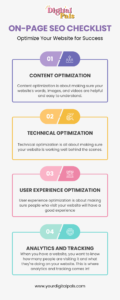On-page optimization is an essential aspect of SEO. An on-page optimization checklist serves as a handy tool that helps ensure that all the necessary elements are in place making it easier for search engines to understand your website’s content and its layout. While it’s just one piece of the SEO puzzle, but it makes a big difference in the search engine results page (SERP).
In this article, we’ll go through a comprehensive on-page SEO checklist. As a result, this will help you optimize your website for success.
On-Page Optimization Checklist – Get Your FREE Copy Below!

1. Content Optimization
Content optimization is about making sure your website’s words, images, and videos are helpful and easy to understand. It includes four important things:
- Keyword research and selection
Research target keywords that users might search for when looking for information related to your website. Also, make sure that you understand your user’s search intent. It might be short-tail or long-tail keywords. These keywords can then be incorporated into your content. As a result, it will be easier for search engines to understand what your content is about. Thus, your website will rank higher in the search engine results page.
- Utilize title tags, header tags, and meta descriptions
These are all HTML tags that help search engines understand the content and structure of your website. Title tags appear at the top of your browser and are used to describe the content of your page. Meta descriptions are being used to provide a summary of the content on your page. Header tags (H1, H2, H3, etc.) are used to structure your content and provide an outline of the information on your page.
- Optimizing content for readability and relevance
Create high-quality content that is easy to read and relevant to your target audience. Also, use clear and concise language and organize your content into logical sections. Your contents should provide helpful information that meets the needs of your audience.
- Use of images and videos to enhance content
Include relevant images and videos in your content that are engaging. Make sure that it help users understand your message more . In addition, this also helps improve the overall user experience of your website.
2. Technical Optimization
Technical optimization is all about making sure your website is working well behind the scenes. It includes four important things:
- Site speed and load time optimization
Ensure that your website loads fast, so that people don’t get frustrated waiting for it to load. If your website takes too long to load, people might leave and go to a different website instead. It is essential to have this in your on-page optimization checklist
- Mobile responsiveness and usability
Make sure your website looks good and functions well when viewed on mobile devices. Many people use their phones to browse the internet, so it’s important that your website is easy to use on smaller screens. Use Google’s Mobile-Friendly Test tool if you’re not sure if your site is optimized for mobile users.
- Internal linking and site structure
Determine if your website is well-organized and easy to navigate. Moreover, make it easy for people to find the information they need by linking to other pages on your website.
- URL structure and canonicalization
Make sure your website’s web addresses (called URLs) are easy to read and understand. Additionally, make sure that there is only one URL for each page on your website. This helps search engines understand your website better and can improve your SEO.
3. User Experience Optimization
User experience optimization is about making sure people who visit your website will have a good experience. It includes four important things:
- Creating a clear and easy-to-use navigation menu
Make sure people can easily find what they’re looking for on your website. You want to make it easy for them to click on things and go to the pages they want to see.
- Providing a search box for easy site navigation
Put a little search box on your website where people can type in what they’re looking for. This makes it even easier for people to find what they want on your website.
- Ensuring your website is easy to read and accessible to everyone
Make sure people can easily read the words on your website, even if they have trouble seeing or hearing. You can do things like using big, clear words, or even putting words in different colors. It is essential to have this in your on-page optimization checklist.
- Optimizing for rich snippets and featured snippets
Ensure your website shows up in a special way when people search for things on the internet. You can do this by adding extra information to your website. As a result, it helps search engines understand what your website is about.
When you do this, your website will show up at the very top of the search results. Thus, helps people know that your website is exactly what they’re looking for.
4. Analytics and Tracking
When you have a website, you want to know how many people are visiting it and what they’re doing on your website. This is where analytics and tracking comes in! There are three essential steps you should take:
- Install Google Analytics to track website traffic and user behavior
Google Analytics helps you see how many people are visiting your website and what pages they’re looking at. You can use this information to make your website better and see if people are finding what they’re looking for.
- Set up conversion tracking (e.g. form submissions, purchases)
Track specific things that people do on your website, like filling out a form or buying something. You can use this information to see if your website is helping you meet your goals. For example, getting more people to sign up for your newsletter or buying your product.
- Keep tabs on your site’s performance and tweak it as needed
Check your website often to see how it’s doing and making changes if something isn’t working. For example, a lot of people leave your website without viewing many pages. You may need to make it easier to use or more interesting. You can use the information from Google Analytics to help you make these decisions.
Why is having an On-Page Optimization Checklist important?

Avoids Overinsight
An on-page SEO checklist ensures that a page contains all essential on-page elements. As a result, aids in reducing the likelihood of making errors. For example, missing meta descriptions, incorrect image alt tags, or a lack of internal linking.
Standardize Optimization Efforts
An on-page optimization checklist can help standardize optimization efforts. Thus, ensuring that the same steps are being taken for every page on a website. This can help streamline the optimization process and make it more efficient.
Provides Structured Approach
Structured on-page SEO helps avoid errors. Make sure that all optimization efforts are properly targeted. As a result, it can help improve the quality of the optimization efforts. Moreover, it will increase the likelihood of achieving higher rankings.
Track Progress
An on-page optimization checklist can help track progress. In a sense, this offers a clear image of the things done as well as the things that are still pending. This can help ensure that all necessary optimizations are being completed. Also, it helps to identify areas that need further attention.
Helps with Team Collaboration
An on-page optimization checklist can help teams collaborate more effectively. Thus, ensuring that everyone is on the same page and working towards the same goals. It can also help with training new team members on the optimization process.
Final Thoughts
In conclusion, by following this on-page SEO checklist, you can ensure that your website is being optimized for success. While there are many other ranking factor that contribute to SEO success, on-page optimization is an essential first step in the process. By optimizing your website for on-page SEO, you can increase your visibility, drive more traffic to your site, and ultimately achieve your business goals.

